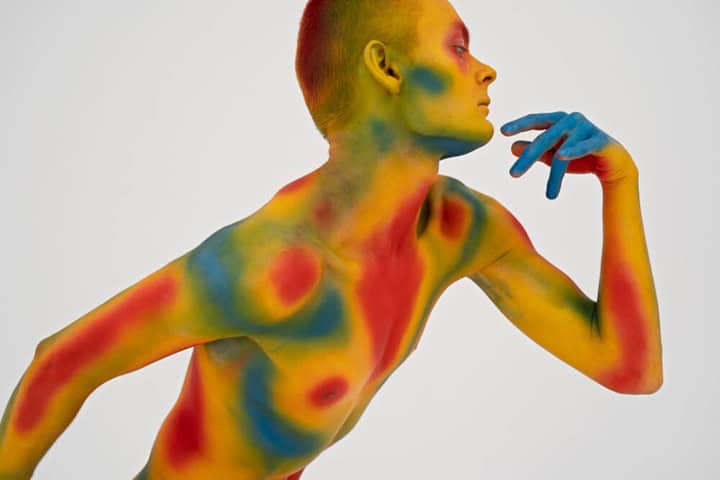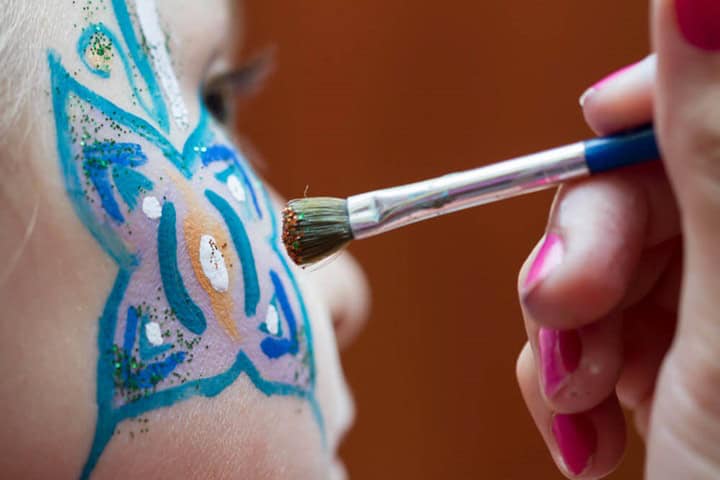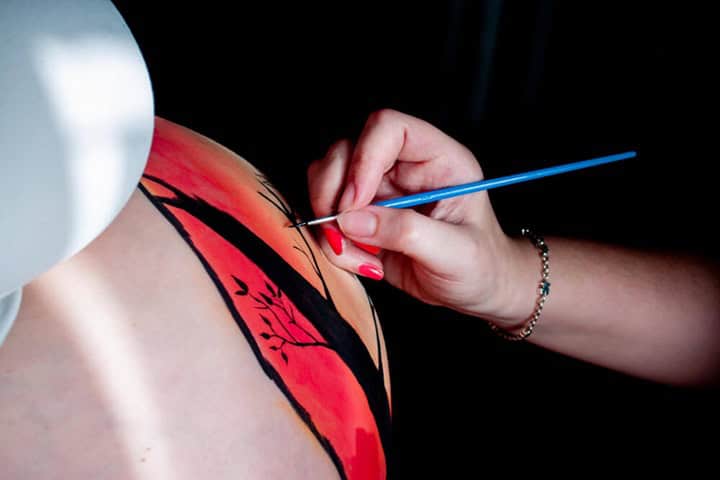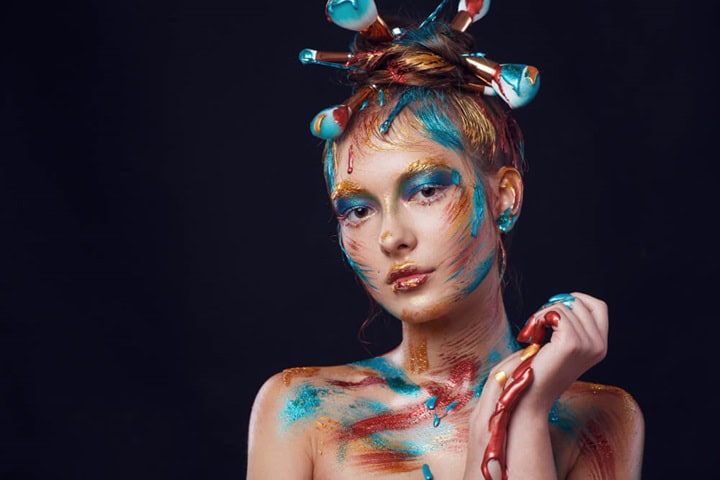Body Painting Ideas For The Stage: Simple Skin Body Art Ideas To Try
7th February, 2025
Unleash your inner artist with body painting, an ancient art form turned modern spectacle! Discover how this vibrant practice can transform any stage into a visual masterpiece.
Face and body painting is a form of artwork that, in recent years, has transcended to new levels, from the stage to comic con events. From tribal ceremonies to modern festivals, body painting has evolved into a stunning expression of human creativity and individuality. In this article, we will explore unique body painting ideas, essential techniques, and safety tips to help you master the art of skin body painting. Whether for fun, professional events, or artistic displays, learn how to bring your visions to life safely and spectacularly.
Key Points:
- Explore the history and cultural impact of body painting.
- Uncover a range of body painting concepts and methods suitable for beginners to experts.
- Learn how to properly prepare and safeguard the skin before painting.
- Acquire effective tips to enhance the durability and appearance of your body art.
Elevate your body art with Mehron Edge face and body paint
What Does A Body Painter do?
Body painters can transform human skin into remarkable canvases, showcasing their creativity through skin body painting and other decorative techniques. Using primarily water-activated face and body paints, these artists execute stunning visual displays that can serve numerous purposes including:
- Turning the human body into a living, breathing piece of art.
- Drawing attention at events through dynamic and colourful presentations.
- Adding an element of fun and uniqueness to gatherings or personal projects.
- Elevating outfits for parades, conventions, and other thematic events.
- Participating in both local and international body painting festivals.
Please note that body art ideas extend beyond mere paint, as it also incorporates temporary tattoos, henna, and glitter, making the realm of body painting as diverse as it is colourful.
Is Body Painting Safe?

When executed with appropriate materials, body painting is generally safe. However, the use of non-skin-safe products such as acrylics or spray paints can lead to adverse reactions like skin irritation or allergic responses. To ensure safety for yourself, only high-quality, skin-friendly paints from trusted sources should be used. This careful selection helps prevent the risks of chemical burns and other skin issues, affirming the necessity for using only the best body painting supplies.
The Origins and Symbolism of Body Painting
Body painting has ancient roots, with evidence dating back to the paleolithic era (the Old Stage Age era, dating back to 2.6 million years ago). Indigenous tribes used natural pigments derived from ashes, plants, and animal products to decorate their bodies for various rituals and practical purposes:
- Ceremonial Use: Specific colors and patterns were used in rituals to represent different meanings or invoke protection.
- Camouflage: Hunters employed body paint to blend into their surroundings, a practice still observed today.
- Beautification and Religious Practices: Over time, body painting evolved to include aesthetic enhancements and religious expressions.
These practices highlight the deep cultural significance of body painting, illustrating its role in celebration, mourning, and spiritual connection in indigenous cultures. In contrast, modern body painting often focuses more on artistic expression or personal decoration, moving away from spiritual or communal significance to emphasise visual and aesthetic impact.
Preparing for a Body Painting Session

Whether you’re planning a simple body painting session or an elaborate portrayal, understanding the step-by-step process of how body painting works is crucial for achieving spectacular results.
1. Setting the Stage and Skin Cleaning
The first step in any body painting project is to ensure that the model’s skin is primed and ready. This involves thorough cleaning to remove any oils, dirt, or makeup that could interfere with paint application.
Using a gentle soap and warm water, cleanse the skin thoroughly, and avoid applying any lotions or creams that might create a barrier between the paint and the skin.
Alternatively, let the model take a shower with a gentle, non-oily soap to remove any dirt, oils, or residues that could prevent the paint from adhering correctly. It’s crucial that the model avoids any exfoliation or abrasive treatments that could irritate the skin before painting.
After showering, the skin should be gently towel-dried without applying any lotions, oils, or other products like bug spray or sunblock.
2. Sketch and Design
Before any paint touches the skin, it’s important to have a clear plan. Sketching the design on paper allows the painter to visualise the artwork and make any necessary adjustments before the actual painting begins.
This sketch serves as a blueprint and can be particularly helpful for complex designs or when coordinating with other elements of a costume or event.
3. Applying a Barrier Spray
To protect the skin and aid the durability of the paint, consider applying a barrier spray prior to painting.
This spray helps to prevent the skin from producing oils and sweat that could smudge the design. Barrier sprays are a key step in skin body painting, especially for long sessions or under hot conditions where the model might perspire.
4. Comfort and Care
Ensuring the comfort of your model is crucial, particularly for sessions that may last several hours.
Provide a soft, cushioned surface for the model to stand or sit on. If the environment is cool, arrange a heat source nearby to keep the model warm, as the application of wet paint can feel quite cold.
Constant communication is key—encourage the model to hydrate regularly and to shift positions to avoid cramping or discomfort.
Remember that the comfort of the model is the most important. Ensure they have a comfortable place to sit or stand, and keep the environment warm enough, as the paint can feel cold upon application.
Regular breaks are needed as well, not only for the model’s comfort but also to maintain their energy levels and prevent any discomfort or fatigue.
What Tools To Use With Body Painting Ideas
Choosing high-quality tools is essential for effective body art. Here are the basic tools that you will need when preparing for body painting:
- Brushes: Opt for synthetic brushes in various sizes—from large flat brushes for broad strokes to small detail brushes for intricate designs.
- Sponges: High-density sponges, specifically designed for body painting, help apply paint quickly and evenly. Avoid regular makeup sponges, as they do not perform well with body paint.
Paint Application Techniques

Body paints are available in various forms, such as cakes or liquids, and can be applied with brushes or sponges. Here’s how to effectively use these tools:
- Water-Activated Paints: Start by slightly wetting a sponge or brush, then swirl it over the paint until it reaches a creamy consistency. Apply with gentle taps or strokes to build up coverage evenly.
- Brush Techniques: Use a kabuki brush for broad, smooth coverage, and smaller brushes, like filbert or round brushes, for detailed work. Each type of brush creates different textures and effects, allowing for creativity in your design.
Advanced Techniques for Applying Liquid Body Paints
Liquid body paints, whether water or alcohol-based, offer unique challenges and opportunities in body painting. These mediums are versatile for creating detailed and smooth finishes that are difficult to achieve with other types of paints.
Liquid body painting can be done with tools similar to those used for other types of paints but does not require the addition of water.
Start by dipping your brush or sponge directly into the paint. It’s important to achieve the right consistency—thick enough to cover but thin enough to spread evenly without clumping.
Use a stippling technique with a sponge for an even base coat or brushes for finer details.
Want to add 3D effects to your body art? Learn how to use scar wax to create stunning, realistic special effects
Using an Airbrush

For a truly professional finish, SFX airbrush makeup is the preferred method among body painting professionals. This technique uses an air compressor and an airbrush gun to spray a fine mist of paint, allowing for seamless coverage and incredible detail that traditional brushes can’t match.
- Setup: Load the airbrush gun with your chosen paint, thinned as necessary.
- Technique: Hold the airbrush about 6-12 inches from the skin and use steady, even strokes to apply the paint. Adjust the pressure to get the desired effect, from subtle shading to vibrant layers.
- Learning: Explore online tutorials to improve your airbrush skills. Practice is essential, as the control and finesse required take time to develop.
Shop our innovative Iwata Z Neo Makeup Airbrush System for your airbrushing techniques
Final Touches with Setting Spray
To improve the effectiveness of your body art painting, consider applying a setting spray after the paint has dried. This step helps to seal the paint, reducing the risk of smudging and providing resistance against sweat and light contact with water.
Removing Body Paint
Removing body paint is generally straightforward but requires careful attention to avoid staining:
Use a body-safe soap and warm water, applying gently with a sponge or cloth. For stubborn areas, a specialised body paint remover or oil-based product might be necessary. Alternatively, try these techniques:
- Use a sponge or soft rag dampened with warm water and a mild face and body art soap. Gently scrub the painted areas to loosen the paint.
- Rinse the area thoroughly with warm water. For persistent stains, repeat the washing process until the skin is completely clear.
- If stains persist, apply a gentle lotion, let it sit for 30 minutes, then wash and rinse again. This can help lift residual pigments.
Addressing Oil-Based Body Paint
Oil-based paints require a different approach due to their resistant nature:
- Apply a layer of baby oil or a specialised remover to break down the paint. This helps in loosening the paint from the skin.
- Follow up with a strong soap and warm water wash to ensure all oily residues are removed, leaving the skin clean and paint-free.
- Be mindful of the surfaces you clean near, as some materials like fiberglass can stain.
Master Your Body Painting Techniques Now
In conclusion, mastering body painting involves understanding various techniques, from applying water and alcohol-based paints to navigating the intricacies of oil-based variants. Proper preparation and removal methods ensure skin health and make the painting experience as enjoyable as possible. Whether you’re exploring simple body painting ideas or complex designs, dedication to the craft will lead to stunning results and a rewarding journey in the art of body painting.
Want to take your body painting to the next level? Check out the annual World Bodypainting Festival today
FAQs
What types of paint are safe to use for body painting?
How can I make my body painting last longer?
Can body painting be harmful to the skin?
Sources
World Bodypainting Festival. (2012) Homepage. [online] Available at: https://bodypainting-festival.com/en/ [accessed 09/01/2025]
Hey there! I’m Isabelle Kerrington, and I’m thrilled to share my passion for the performing arts through my blog. Focusing on theatre makeup, my posts will cover everything from product recommendations to helpful tips and engaging tutorials. Join me on this exciting journey as we explore the magical world of theatre makeup together.
Leave a Reply